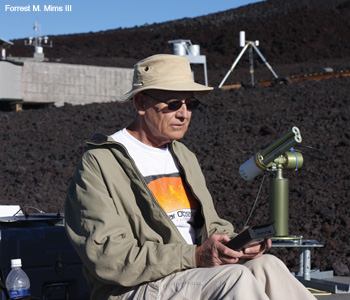 The author uses an LED Microtops II next to a Cimel robotic sun photometer at Hawaii’s high altitude Mauna Loa Observatory. Five LEDs replace the usual photodiodes and filters in the Microtops shown here.
The author uses an LED Microtops II next to a Cimel robotic sun photometer at Hawaii’s high altitude Mauna Loa Observatory. Five LEDs replace the usual photodiodes and filters in the Microtops shown here.
The history of sun photometry—the practice of measuring atmospheric aerosols and water vapor by detecting sunlight—traces back at least a century. Traditional photometers detect sunlight using optical interference filters and broadband silicon photodiodes. But while silicon photodiodes are very stable and have low temperature sensitivity, the filters are expensive and can be subject to unpredictable drift or degradation that can severely affect the quality of measurements.
In 1989, I devised a filterless method for measuring sunlight by using light-emitting diodes (LEDs) as spectrally selective photodiodes—a design that greatly improves the long-term stability of sun photometers. The first LED sun photometer, which was assembled from components that cost less than $50, exhibited minimal calibration drift over two decades.
The device incorporates two near-IR LEDs, one of which detects the 940-nm water vapor absorption band and the second of which detects a nearby reference band. Since February 1990, the ratio of the signals from these LEDs has provided the total column abundance of water vapor over my South Texas site at solar noon to within 3 percent of the mean of 3.5 years of more recent measurements made by the nearest GPS receiver in the National Oceanic and Atmospheric Administration’s (NOAA) GPS Integrated Precipitable Water project. Measurements of the atmosphere’s aerosol optical density (AOD) can be made with similar accuracy.
Here, I provide a history of handheld sun photometry; recount the development of LED sun photometry and radiometry; and provide some resources for scientists, educators, students and science enthusiasts who are interested in working on their own sun photometry projects.
Frederick Volz introduces the hand-held sun photometer
A century ago, scientists at the Smithsonian Institution’s Astrophysical Observatory (APO) demonstrated a new way to measure direct sunlight with enough accuracy to assess aerosols, ozone and water vapor using simple spectrometers. The APO also showed that the mean intensity of solar radiation at the top of Earth’s atmosphere (the solar constant, Io) could be inferred from a series of a dozen or so measurements of direct sunlight (I) at Earth’s surface during a clear morning.
Although the APO’s solar instruments could be transported in carrying cases, they were not designed for hand-held operation. It wasn’t until the mid-1950s that Frederick Volz pioneered hand-held sun photometry. In 1957, he developed a simple photometer that measured AOD with a selenium detector and a green-transmitting 500-nm filter. The photocurrent produced by the device was displayed on a small analog meter.
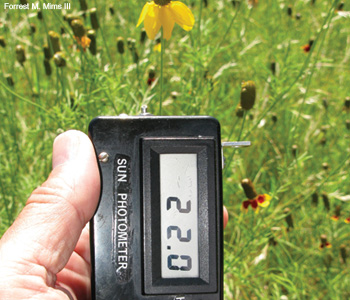 This six-channel LED sun photometer was the second to use light-emitting diodes as spectrally selective photodiodes. The author used it to measure aerosol optical thickness and total column water vapor over South Texas from 1991 to 2002.
This six-channel LED sun photometer was the second to use light-emitting diodes as spectrally selective photodiodes. The author used it to measure aerosol optical thickness and total column water vapor over South Texas from 1991 to 2002.
Volz subsequently improved his instrument by adding filter channels and replacing the selenium cell with a silicon photodiode and amplifier. Volz’s photometers were used in various atmospheric haze studies and networks. Unfortunately, filter drift and the lack of calibrations contaminated the data from the networks.
Volz also developed a photometer that had a filter with a passband over the 940-nm water vapor absorption band and a nearby band that was unaffected by water vapor. This instrument could be used to measure the total water vapor in a column through the atmosphere. In May 1965, the meteorologist Robert A. McCormick visited Hawaii’s fledgling Mauna Loa Observatory (MLO) and gave MLO Director Howard Ellis a Volz photometer to calibrate in the pristine air of that alpine site, 3,417 meters (11,210 feet) over the Pacific Ocean. Ellis still recalls rising at sunrise to calibrate the instrument using the century-old Langley method, in which direct sun readings are taken at frequent intervals over a wide range of air masses as the sun rises in the eastern sky.
Volz photometers also served as models for Glenn Shaw, an atmospheric scientist working at the University of Alaska’s Geophysical Institute in the mid-1970s. (Today he is a professor emeritus.) Shaw developed his own hand-held and automated instruments and traveled to Mauna Loa many times to calibrate them. In 1976, he measured aerosols from the eruption of the Alaskan volcano Mt. Augustine. And in 1979, he became the first to photograph and measure the AOD of Asian dust clouds drifting over Hawaii on their way to North America.
In 2008, I worked with Glenn’s son Joseph, who directs the Optical Technology Center at Montana State University, to calibrate several of his father’s sun photometers during a pleasant morning at MLO. (View an elapsed time movie of the occasion.)
Light-emitting diode (LED) sun photometers
My own work on sun photometers traces back to my days as a high school senior in 1962. Observing that an electromagnetic speaker can double as a microphone, I wondered whether semiconductor light detectors could emit light as well. To test the hypothesis, I connected a cadmium sulfide photocell to the terminals of a high-voltage automobile ignition coil.
As one might expect, the surface of the cell glowed brightly when power was applied to the coil. Most of the glow was due to the high voltage discharge. However, there were distinct points of bright green light emitted by the CdS, seemingly proving the hypothesis, since the green wavelength of the emitted light approximated the peak detection wavelength of the photoresistor. (This finding would not have surprised a semiconductor physicist, but I wasn’t aware of the details at the time.)
While studying government and history at Texas A&M University in 1966, I repeated my semiconductor experiment by applying square wave pulses of a few volts to a silicon solar cell. The cell emitted pulses of near-IR that were received by a second solar cell connected to the input of an audio amplifier; this generated a tone with a frequency that matched the pulse rate applied to the solar cell used as a source.
After LEDs and laser diodes became widely available in the early 1970s, I assumed that they might also double as light emitters and detectors. Simple experiments showed that audio frequency signals could be transmitted bidirectionally between two LEDs or laser diodes. These experiments worked best when LEDs and lasers with the same emission wavelength were used as dual-purpose emitter-detector pairs.
Soon, I was transmitting voice bidirectionally through free space using a single GaAs:Si near-IR LED as a dual-function emitter-detector at each end of the link. I also sent voice and digital signals bidirectionally through optical fibers using a single GaAsP red LED at each end of a fiber. I published these results in various electronics books and magazines for hobbyists.
While preparing to take over “The Amateur Scientist” column in Scientific American magazine in 1989, I developed several handheld sun photometers for measuring direct UV, the ozone layer and visible and near-IR wavelengths of sunlight, including two homemade TOPS (total ozone portable spectrometer) instruments that were placed in daily service on February 4, 1990. These instruments used GaP photodiodes and narrow-bandpass interference filters.
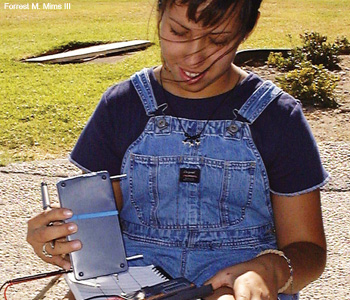 The author’s daughter Sarah used a GLOBE sun photometer to measure the aerosol optical depth across Texas and New Mexico in 2000.
The author’s daughter Sarah used a GLOBE sun photometer to measure the aerosol optical depth across Texas and New Mexico in 2000.
I processed the ratio of direct UV-B at 300 and 305 nm (measured by TOPS) using an empirical algorithm based on several months of comparisons of total ozone assessed over my site by NASA’s TOMS (total ozone mapping spectrometer) on the Nimbus-7 satellite. This algorithm tracked TOMS ozone measurements well enough for both TOPS instruments to identify a drift in the measures made by the satellite sensor in 1992; this finding was subsequently confirmed by the world standard Dobson spectrometer (I83), and I published about it in Nature.
The high-quality UV filters used in the two TOPS remained very stable for about five years, but the visible and near-IR interference filters used in other photometers often rapidly degraded. To bypass the filter problem, I added two near-IR LEDs suitable for detecting column water vapor to one of my sun photometers. I started using that instrument on February 4, 1990, and it worked so well that I have continued to use it ever since.
I built another pocket-sized, six-channel LED sun photometer in 1991 and described it in a paper in Applied Optics. This instrument was used for near daily measurements from December 1991 to June 2002. The long-term stability of both of these original LED sun photometers was far better than that of devices that use filters. Annual calibrations at MLO showed that the Io of the four visible channels of the six-channel instrument remained within 1.9 percent of their original values.
The LEDs used in these devices had detection bandpasses that ranged from about 10 to 75 nm, with typical bandpasses for green and red LEDs of 75 and 25 nm, respectively. While these bandpasses are greater than the 10-nm bandpass of the filters commonly used in sun photometers, they regularly yield very flat Langley plots (r2 > 0.99) at MLO.
The temperature coefficient of LEDs is higher than that of silicon photodiodes, but this has not been an issue for my daily measurement program. That’s because I kept my handheld LED photometers indoors at room temperature and transported them in a closed case prior to use. MLO calibrations are conducted from inside a car maintained near 21° C.
In order for LED sun photometers to operate in continuous sunlight, one must apply a temperature correction to the measurements. Alternatively, the LED can be heated, as in a one-of-a-kind Yankee Multi-Filter Rotating Shadow Band Radiometer (Model MFR-7), in which seven LEDs have replaced the filtered photodiodes. This instrument has been in use for more than five years at one of my sites.
The advantage of using LEDs as detectors in radiometers is they can measure only specific wavelength bands of the full sky’s irradiance. For example, a red LED or a blue-red pair of LEDs can measure the photosynthetic components of sunlight as well as a more costly filtered silicon photodiode.
VHS-1 Sun Photometer
The six-channel LED sun photometer that I described in Applied Optics attracted the attention of an organization called TERC, which is devoted to improving science and math education. In 1996, the organization challenged me to develop an inexpensive student LED sun photometer that used a green LED. The device would be used to measure the aerosol optical thickness of the atmosphere at the peak of human vision.
The main requirement was that the device be assembled without soldering. I managed this by using a plastic, solderless breadboard for the LED, operational amplifier and feedback resistor. The power switch had screw terminals, and I used output jacks with connector nuts for the external digital voltmeter. Two small angle brackets affixed by hardware to the side of the enclosure provided a sun alignment target. I assembled the instrument—dubbed the Visual Haze Sensor (VHS-1)—inside a black plastic case used to store a VHS tape. The assembly holes and sunlight aperture were easily formed with a small knife.
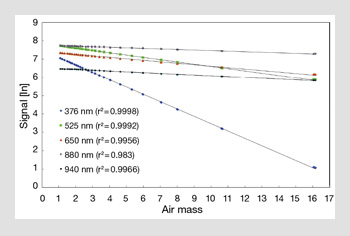 Example of an extraordinarily flat Langley plot for a Microtops II modified with LEDs as spectrally selective photodiodes during a clean morning at Mauna Loa Observatory.
Example of an extraordinarily flat Langley plot for a Microtops II modified with LEDs as spectrally selective photodiodes during a clean morning at Mauna Loa Observatory.
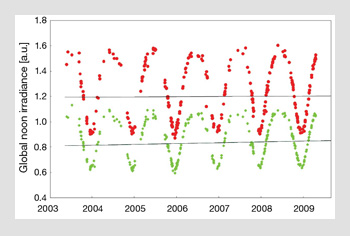 Full sky irradiance measured at solar noon on totally clear days by a Radio Shack Sun and Sky Monitoring Station. The data show no noticeable drift during the six years the instrument has been used at the author’s South Texas site.
Full sky irradiance measured at solar noon on totally clear days by a Radio Shack Sun and Sky Monitoring Station. The data show no noticeable drift during the six years the instrument has been used at the author’s South Texas site.
A prototype VHS-1 yielded surprisingly impressive results, including a virtually flat Langley calibration plot (r2 = 0.999) over an extended air mass range of 1.6 to 10. During a pilot study at the Kailua-Kona, Hawaii, campus of the University of the Nations, Dean of Science J. Kuhne and students C. Sigamoney and B. Maxwell built three VHS-1s from scratch using local supplies and a circuit diagram and sketch I had prepared. Sigamoney and Maxwell conducted simultaneous Langley tests near sea level on a clear afternoon that yielded a correlation (r2) of 0.998.
Based on the success of this pilot study, the VHS-1 was included in the science curriculum at the University of the Nations. Over several years, some 75 students from 16 countries built the devices, many of which were used during field trips to Mauna Loa. In addition, during three workshops, more than 100 science teachers assembled VHS-1s from kits. Meanwhile, I described how to make a basic LED sun photometer in a Radio Shack project book that sold hundreds of thousands of copies.
Some students earned recognition for their work with sun photometers at science fairs around the country. In 1997, Clint Beicker, then a high-school sophomore in Seguin, Texas, used a homemade VHS-1 that he built entirely on his own to measure the AOD of the emission plume from a coal-fired power plant. He later made measurements across San Antonio that identified a bubble of haze over the city.
GLOBE sun photometer and LED Microtops
In the Applied Optics paper that described the six-channel LED sun photometer, I stated that my goal was to develop an inexpensive instrument that could be used by scientists, students and others in developing countries. I was able to meet this objective through the support of the GLOBE program, which retained David R. Brooks of Drexel University and me over a six-year period to develop a two-channel (green and red) sun photometer; produce a protocol for its use; and conduct annual calibrations of several reference instruments at MLO, where I had been calibrating many sun photometers since 1992.
Some GLOBE schools provided regular observations that were added to the organization’s database. Although GLOBE’s interest in atmospheric monitoring has waned significantly, Brooks and I continue to maintain standard instruments, which I calibrate during my annual visits to MLO.
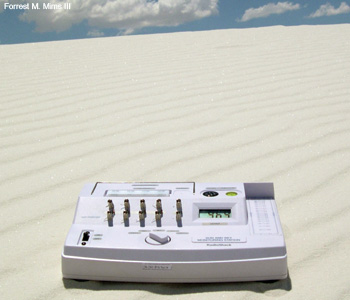 Radio Shack’s Sun and Sky Monitoring Station ($29.99), shown here at White Sands, N.M., U.S.A. The kit functioned as both a sun photometer and a full-sky radiometer. Its four LEDs (green, red and two IR) measured optical thickness of the atmosphere, the photosynthetic radiation responsible for plant growth and total column water vapor.
Radio Shack’s Sun and Sky Monitoring Station ($29.99), shown here at White Sands, N.M., U.S.A. The kit functioned as both a sun photometer and a full-sky radiometer. Its four LEDs (green, red and two IR) measured optical thickness of the atmosphere, the photosynthetic radiation responsible for plant growth and total column water vapor.
The reference GLOBE sun photometers have proven to be very stable. However, I attained even better results using the first LED Microtops, a microprocessor-controlled sun photometer that I developed with funds from a 1993 Rolex Award. The award enabled me to hire Scott Hagerup to design the instrument, which had three UV-B channels to assess the ozone layer and two near-IR channels for measuring total water vapor (940 nm) and AOD (1,000 nm). I replaced the photodiodes and filters of one Microtops with five LEDs. Annual calibrations at MLO from 1996 to 2001 yielded minor changes in the Io of the four visible channels.
After Solar Light introduced a more sophisticated version of this instrument known as Microtops II, I replaced the filters and photodiodes of one such instrument with a set of GLOBE LEDs. I have used this instrument regularly since 1999, and my annual calibrations at MLO over the subsequent decade affirm the remarkable stability of LEDs as detectors. The table below shows the annual drift in Io of each channel from 1999 to 2009.
 Annual drift of the extraterrestrial constant (Io) measured by the LED Microtops II during Langley calibrations at the Mauna Loa Observatory from 1999 to 2009.
Annual drift of the extraterrestrial constant (Io) measured by the LED Microtops II during Langley calibrations at the Mauna Loa Observatory from 1999 to 2009.
My GLOBE colleague David Brooks reviewed these results and wrote, “Overall, a pretty impressive case for these devices. This drift is within the ‘noise’ that you would get from MLO calibrations, even on consecutive days, and smaller than the year-to-year change in ET values for our reference [GLOBE] sun photometers.”
The LED version of Microtops II continues to be an experimental instrument that is intended for studying the long-term stability of LEDs as spectrally selective photodiodes. The standard instrument with filtered photodiodes provides even better results over the life of the filters due to the reduced temperature sensitivity of its silicon photodiodes and the narrower bandpass of its filters (10 nm).
Radio Shack Sun and Sky Monitoring Station
For many years, I wrote Radio Shack’s project books and developed some of their electronics lab kits. In 2001, I proposed a very different kind of kit—the Radio Shack Sun and Sky Station. Radio Shack assigned me to work with Philip Tan of the same product development team in China with which I had worked to develop two electronics lab kits.
The product consisted of a white plastic console about the size of a cigar box that used a green, red and two near-infrared LEDs to measure full sky irradiance, which was indicated by arbitrary (uncalibrated) units on a digital readout. A four-position rotary switch selected the LED whose signal was to be indicated on the digital readout. A carefully designed diffuser panel provided a good cosine response.
A bubble level and adjustable feet permitted the console to be leveled. The sharply defined shadow from a plastic gnomon on the right side of the console indicated on a printed scale the angle of the sun over the horizon and the air mass. A removable collimator assembly stored in the right side of the console could be snapped over the diffuser panel to transform the product into a four-channel sun photometer complete with a sunlight alignment aperture and target.
To meet Radio Shack’s requirement that the product be classified as a kit, the gain resistors for the operational amplifiers for each of the four channels were left uninstalled. The customer was provided with assorted fixed resistors, which were installed between connection springs on the front of the console.
The Sun and Sky Station came with a 64-pp. instruction manual, which I prepared. The manual explained in detail the basics of sun photometry and radiometry and how the product could be calibrated using the Langley method. It also described how to compare readings from the product with those made by various remote sensing satellites.
Following the busy 16-month development process, the Sun and Sky Station was distributed to Radio Shack stores in spring 2003. A working sample of the product arrived just in time for my annual calibration trip to MLO. Radio Shack sold some 12,000 Sun and Sky Stations for $29.99 each—which may make the Sun and Sky product the biggest selling sun photometer and radiometer to date.
The Sun and Sky Station is no longer available from Radio Shack (although eBay sometimes has them), but I have continued to make measurements with the original product sample. This near-daily time series began in May 2003 and has included annual calibration sessions each spring at MLO.
The results of these calibrations are not as good as those with the LED Microtops. The cleanest results I have achieved from 2003 to 2009 yielded an annual drift in Io of -0.25 percent for the green channel and 1.3 percent for the red channel. However, measurements on clear days at solar noon at my Texas site from May 2003 to April 2009 provide very uniform results. The full sky trend is 0.75 percent (green) and 0.12 percent (red) per year, and the annual direct sun trend is 0.61 percent (green) and 0.16 percent (red). All things considered, these results seem quite reasonable for a $30 instrument.
The future
The GLOBE protocols that David Brooks and I have developed are still available at www.globe.gov. Hopefully GLOBE will again recognize that students can perform high-quality aerosol and water-vapor retrievals using LED sun photometers. Meanwhile, various organizations in the United States, Europe and Asia have built LED sun photometers and published papers describing their results. Student projects continue as well. For example, students in the Netherlands have compared their AOD measurements using GLOBE sun photometers with those made by robotic Cimel sun photometers and the Terra satellite.
I hope to find support to continue my annual calibrations at MLO and to provide a comprehensive report on the long-term performance of LED and other inexpensive sun photometers. In February 2010, I will have made 20 years of near-daily solar noon observations here in South Texas. I am also developing new kinds of instruments that employ LEDs as spectrally selective detectors.
Forrest M. Mims III, a Rolex Award recipient and author of more than 60 books about electronics and science, was recently named “one of the 50 best brains in science” by Discover magazine. His history of Hawaii’s Mauna Loa Observatory will be published in 2010 by the University of Hawaii Press.
References and Resources
>> F.E. Volz. “Economical multispectral sun photometer for measurements of aerosol extinction from 0.44 µm to 1.6 µm and precipitable water,” Appl. Opt. 13, 1732-3 (1974).
>> G.E. Shaw. “Sun photometry,” Bull. Am. Meteorological Soc. 64, 4-10 (1983).
>> F.M. Mims, III. “Sun photometer with light-emitting diodes as spectrally selective detectors,” Appl. Opt. 31, 6965-7 (1992).
>> F.M. Mims III. “Satellite monitoring error,” Nature 361, 505 (1993).
>> F.M. Mims III. “An international haze-monitoring network for students,” Bull. Am Meteorological Soc. 80, 1421-31 (1999).
>> F.M. Mims III. “Solar radiometer with light-emitting diodes as spectrally-selective detectors,” Opt. Photon. News 11, 3-4 (2000).
>> D.R. Brooks and F.M. Mims III. “Development of an inexpensive handheld LED-based Sun photometer for the GLOBE program,” J. Geophys. Res. 106, D5, 4733-40 (2001).
>> F.M. Mims III. “An inexpensive and stable LED Sun photometer for measuring the water vapor column over South Texas from 1990 to 2001,” Geophys. Res. Letters 29, 20-1 – 20-4 (2002).
>> F.M. Mims III. “Five years of photosynthetic radiation measurements using a new kind of LED sensor,” Photochemistry and Photobiology 77, 30-33 (2003).
>> D.R. Brooks. Bringing the Sun Down to Earth: Designing Inexpensive Instruments for Monitoring the Atmosphere. Springer (2008).
More about Forrest’s photometers
The VHS-1 lives on as a kit of all necessary supplies, including LED, solderless breadboard, opamp, voltmeter and tools. It is available from Shawn Carlson at SciFair.org. The Concord Consortium supports the VHS-1 with an interactive Web site.
Both kit and assembled and calibrated GLOBE-quality LED sun photometers and silicon solar cell pyranometer are available through David Brooks at the Institute for Earth Science Research Education.
The author’s Web sites (www.forrestmims.org and www.sunandsky.org) include updated charts about his sun photometer and related measurements since 1990 and photographs of MLO. Updates about his 2009 calibration trip to MLO are at twitter.com/fmims.
Financial Disclosure Statement: The author declares an ongoing financial interest in the form of a royalty from sales by the Solar Light Company of Microtops II ozonometers and sun photometers. However, the author receives no royalty for the sale of LED Microtops II. The only such instrument was modified by the author from a commercial unit.
I also serve as an unpaid member of the board of the Institute for Earth Science Research Education, a registered non-profit organization. The IESRE provided a grant to help defray expenses from my 2009 MLO calibration trip.
While I am not associated with scifair.org, its director, Shawn Carlson, is executive director of the Society for Amateur Scientists, for which I serve as paid editor of its monthly Web publication, The Citizen Scientist.
The original development of LED sun photometers was done at my own expense.
